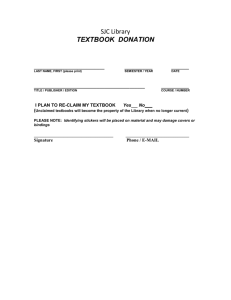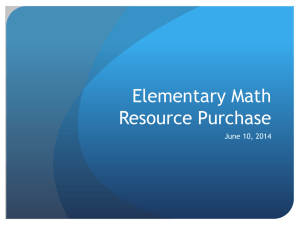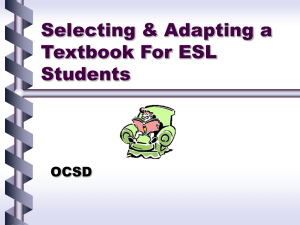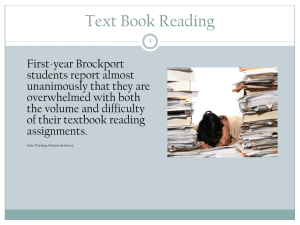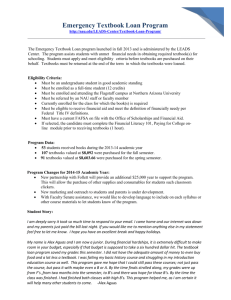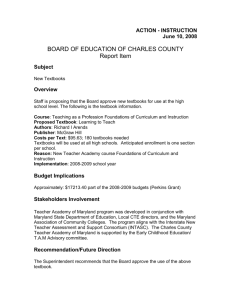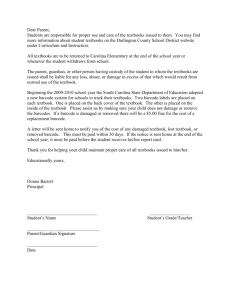Textbook and Learning Materials Policy
advertisement
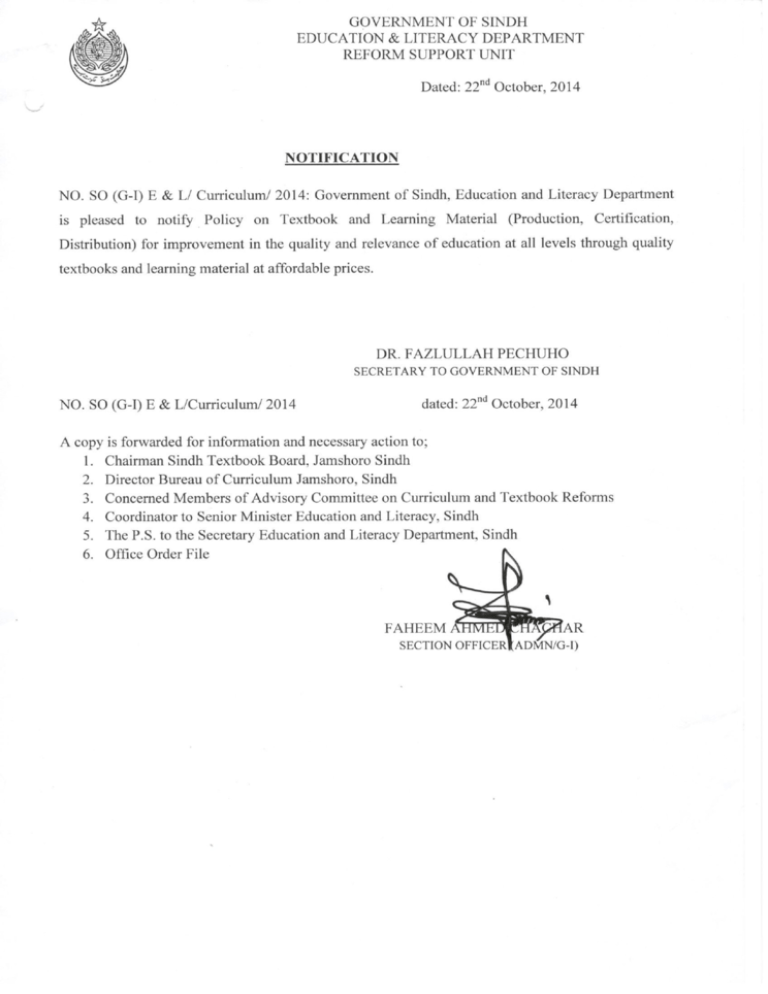
POLICY ON TEXTBOOK & LEARNING MATERIAL August 2014 Policy on Sindh Textbook and Learning Material (Production, Certification, Distribution) 1 POLICY ON TEXTBOOK & LEARNING MATERIAL 1. POLICY ON TEXTBOOK & LEARNING MATERIAL 1.1 PREAMBLE August 2014 The need for Policy on the development, production, certification and distribution of textbook and learning materials for the province of Sindh stems from the devolution of powers to provinces under the 18th Constitutional Amendment Act 2010 of the Islamic Republic of Pakistan 1. The jurisdictional change emerging as a result of omission of the concurrent legislative list empowers the Government of Sindh to legislate and administer in the areas of education policy, planning, curriculum, textbooks, standards, centers of excellence.2 1.2 GOAL Improvement in the quality and relevance of education at all levels through quality textbooks and learning material at affordable prices so that all our children (Early years to grade XII) receive a quality education and are empowered to participate effectively and productively in society. 1.3 OBJECTIVES The objectives of this Policy are to: 1 (i) define fundamental principles and standards for timely development, approval, and availability of textbooks and learning material; (ii) establish performance and service standards to improve efficiency and effectiveness at every stage of textbook and learning material supply chain processes (authorship, production, printing, distribution); The Gazette of Pakistan, Ex.Pt.1,Constitution(Eighteenth Amendment) Act 2010, Act No X of 2010, P267, 20 April 2010 2 Article 70 (4), Entry 37 & 38, Concurrent Legislative List, Schedule IV, Constitution of Pakistan 1973; Entry 37 reads as, “Curriculum, syllabus, planning, policy, centers of excellence, standard of education” 2 POLICY ON TEXTBOOK & LEARNING MATERIAL August 2014 (iii) define quality assurance frameworks for textbooks and learning material production and review / evaluation; (iv) establish transparent and competitive procedures by which textbooks and learning material for free distribution to public and low cost private schools are developed, produced, printed and distributed to ensue best value for money 1.4 PRINCIPLES (i) Quality: The school textbooks and learning material meet the needs of quality standards and reflect local, regional, and international perspectives and approaches in both design and pedagogy (ii) Inclusive: The school textbooks and learning material promote gender equality, human rights, and respect for all (iii) Alignment: The textbooks and learning material are aligned with curriculum to facilitate the achievement of the learning outcomes in the domains of knowledge, skills, and values delineated therein (iv) Learner engagement: Textbooks and learning material are engaging and support effective learning (v) Transparent and competitive: The process of determining school textbooks and learning material for free distribution are developed through a transparent and competitive process so as to provide best value for money (vi) Timeliness: The textbooks and learning material are reviewed and approved so that they are available to all learners right at the start of their academic year 1.5 POLICY ACTIONS: (i) A well regulated, transparent and competitive system of outsourcing textbooks and learning material development as packages shall be introduced in Sindh to achieve quality while ensuring better value for money; (ii) Sindh Textbook Board shall be strengthened as a competent facilitating, regulating and monitoring authority to improve 3 POLICY ON TEXTBOOK & LEARNING MATERIAL August 2014 efficiency in managing authorship, production, copyrights, printing and distribution of textbooks and learning material. The government shall establish performance and service standards for the functioning and managing of the publication of textbook and learning material and shall ensure its compliance; (iii) Sindh Textbook Board shall carry out all procurements in line with Sindh Public Procurement Rules. This shall include but not limited to development, printing, and distribution contracts (performance based) for a minimum of three-years in recognition of major investment on the part of service provider; (iv) The Government shall establish an effective evaluation and certification mechanism to ensure the quality and relevance of textbooks and learning material in a timely and cost effective manner. Bureau of Curriculum is the competent authority to review textbooks and learning materials for alignment with the school education standards and curriculum goals; (v) In the development of textbooks and learning material, Copyright Law regarding Intellectual Property shall be implemented. Infringement shall be dealt with in accordance with the Law. As a matter of urgency, the Government shall establish an Anti-Piracy Committee to undertake anti-piracy activities/measures. Sindh Textbook Board shall hold the copyright of textbooks, and the material development firms / publishers (including authors and illustrators) shall not claim any royalty on their work. All proceeds received in respect of the licensing of copyright shall be owned by Sindh Textbook Board; (vi) Sindh Textbook Board shall develop an effective distribution strategy using EMIS supported technological innovations in delivery and tracking of textbooks down to classroom level; (vii) The Government of Sindh shall take all necessary steps to support the attainment of the overall teaching and learning objectives, through the provision and effective utilization of support structures (eg. libraries and laboratories) and resources (eg. learning materials); 4 POLICY ON TEXTBOOK & LEARNING MATERIAL August 2014 (viii) The Education & Literacy Department3 shall establish standards of good governance and management, for organizations under its administrative control, responsible for the implementation of this policy; (ix) Technical Committee shall be formed to formulate the implementation plan of this policy. The Education Secretary shall chair the Technical Committee. 2. IMPLEMENTATION OF POLICY Technical Committee referred to in Policy Statement shall work to formulate the implementation plan of this policy within 3 months from the notification of this policy. This shall include but not limited to: (i) revisit existing structures of organizations responsible for the implementation of this policy with a view to strengthen and align their activities with the new / revised set of roles and responsibilities (ii) coordinate the execution of the implementation plan and address the operational and procedural issues which may arise during the implementation of this policy (iii) ensure that implementation plan, approved by the Education & Literacy Department, shall be fully implemented on or before the start of 2016 academic year 3 Education and Literacy Department has been bifurcated into two departments (School Education up to matriculation and Higher Education and Research Department) 5 POLICY ON TEXTBOOK & LEARNING MATERIAL August 2014 ANNEXURE I - DEFINITIONS “author” is any natural or legal person who develops a school textbook, teaching resource, and reading materials (other than textbooks) which is published in printing or electronic form. “copyright” is a legal term used to describe the rights that creators have over their literary and artistic works. Works covered by copyright range from books, music, paintings, sculpture and films, to computer programs, databases, advertisements, maps and technical drawings “distributor” is a person or firm who purchase and sells school textbooks and educational teaching resources by wholesale. “facilitator” guide the process of textual material development by sharing the objectives, principles, and ground rules, discuss what they mean, and ask for feedback as to how they use them “ISBN” is the distinctive mark of texts and books for not allowing their duplication and misapplication. “learning material” means additional resource material which supports in the attainment of student learning outcomes for a specific subject at a particular level; “prescribed” means prescribed by the rules or regulations; “printer” is a person or company who provides printing services. “publisher” is a person or company who publishes the authors’ manuscripts, who also develops the entire process of publishing school textbooks, teaching resources, and reading materials (other than textbooks). “quality” means the education which enables all learners to reach their potential in terms of cognitive, psychomotor, social, emotional, critical, creative and problem solving capacities; “regulator” to regulate, in the interest of public, the school textbook and learning material process “review” is a written critical evaluation of a manuscript to ensure it is in line with the curriculum in letter and in spirit and based on specified criteria; “supply chain” means the processes involved in bringing textbooks and learning materials from the hands of the author (or creator) to the end 6 POLICY ON TEXTBOOK & LEARNING MATERIAL August 2014 users (learners and teachers); “textbook” means the learning material which is either in print or in electronic form, developed and maintained in accordance with the curriculum for a specific grades and subjects competent authority; 7 POLICY ON TEXTBOOK & LEARNING MATERIAL August 2014 ANNEXURE II - DESIRABLE LEARNING AND TEACHING MATERIALS4 For many years, classroom materials have been concerned mainly with the provision of textbooks and teachers’ guides. However, textbooks by themselves cannot provide everything required to achieve curriculum objectives. This is particularly true where outcomes-based curricula, studentcentered learning, problem solving and the development of thinking skills are specified. Reading books – supplied in single copies and in sufficient quantities to enable every student to have at least one new title to read at least once a week throughout the school year. These are required at every level of education from primary up to higher secondary. Initially they form a basic support to the achievement of early literacy but also to the inculcation of the reading habit. They help to develop vocabulary, grammar, comprehension and self-expression and eventually to support student research skills. Big books – particularly useful in primary grades. They can be designed and supplied without text (as a cost reduction strategy) so that teachers can write in a variety of local language equivalents. They can be used by teachers to read stories and to show pictures because the illustrations should be big enough to be visible even at the back of large classes. They can also encourage shared reading through pair and small group work. Illustrated word books - (for primary) and appropriate dictionaries at every level in local and international languages and in monolingual and bilingual editions. In upper grades, dictionaries of specialist terminology are also useful (e.g. dictionaries of science, geography etc). Atlases – generally introduced at middle and essential at secondary level. Anthologies – collections of stories for teachers to read to classes, particularly important in primary classes. Rhymes and poetry – to encourage imaginative word use, student creativity and appreciation of the possibilities of language and culture. Grammar books in local, regional and international languages – as references for teachers. 4 Learning and teaching material: policy and practice for provision, Guidance Notes – A DFID practice paper. 8 POLICY ON TEXTBOOK & LEARNING MATERIAL August 2014 Reference and school library books – to encourage further reading, the development of individual student interests, the development of student research skills and to provide extension materials for students and reinforcement materials for others. e-Materials – in recent years access to computers and the internet has generated interest in the provision of e-Materials. Where the internet is unavailable, unreliable or unaffordable, the development of local school networks and the provision of e-materials to schools on CDs/ flash disks can support e-learning via school servers and networks. 9
